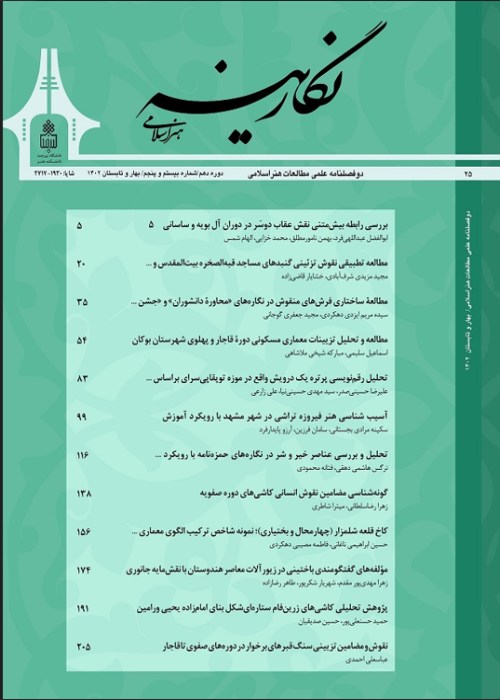A Comparative Study of Visual Properties, Geometric Patterns and Application of Girih Wood-workings in Historic Houses of Darmiyan
One of the traditional arts related to architecture is Girih wood working which is used in different spaces based on structure and components, and therefore has an effective role in the richness of the architectural space. The purpose of this study is a comparative study of visual features and decorative patterns of Girih wood workings in traditional architecture of historic residential houses. The historical period of these works includes the Afshar, Qajar, and early Pahlavi periods, all of which are located in the city of Darmiyan in the province of South Khorasan. The present article is descriptive-analytical in terms of attitude and approach to the problem and content analysis in terms of method. In this study, 5 historical houses including Tavakoli , Abdul Azim Beyk , Abdullah Beyk, Abdullah Khan and Mahdi Khan Houses which possess wooden Girih decorations have been studied . The results of this study show that most of the girih are of mesh type and the least number are of solid type. The most diverse girih can be seen in the house of Mehdi Khan Rafiei. The most common application of girih in the residential architecture of the studied houses is the use of mesh girih in the openings (windows). This type of girih , in addition to providing light and maintaining wind flow, has maintained the privacy of the private space due to its use in the summer living space on the upper floor of the mansion. In terms of matching the quantity and quality of girih works with the historical period of each building, it can be said that the more historical the houses are, the more variety and quality of works there is in residential architecture. Therefore, in the houses belonging to the late Afshar dynasty, such as the house of Abdullah Beyk and the house of Mehdi Khan Rafiei, the art of girih has been used more widely than the houses of Qajar (Abdul Azim Bayk) and Pahlavi (Tavakoli). The research data indicate that at least 11 different types of girih can be identified in the studied houses. The most prolific and diverse geometry of the designs can be seen in the construction of Tavakoli and Mahdi Khan Rafiei Houses. In addition, the most widely used geometry is girih naming "eight and four". According to the results of the present study, Mehdi Khan Rafiei house has the most diverse type of girih making both in terms of geometry of designs and in terms of application and use of girih in interior architecture.
- حق عضویت دریافتی صرف حمایت از نشریات عضو و نگهداری، تکمیل و توسعه مگیران میشود.
- پرداخت حق اشتراک و دانلود مقالات اجازه بازنشر آن در سایر رسانههای چاپی و دیجیتال را به کاربر نمیدهد.


